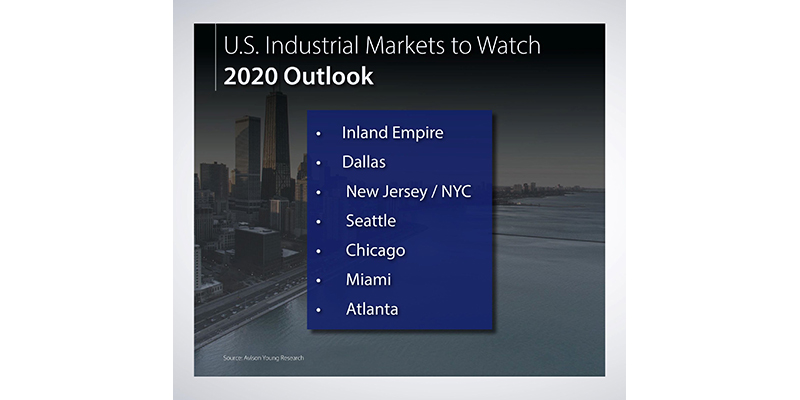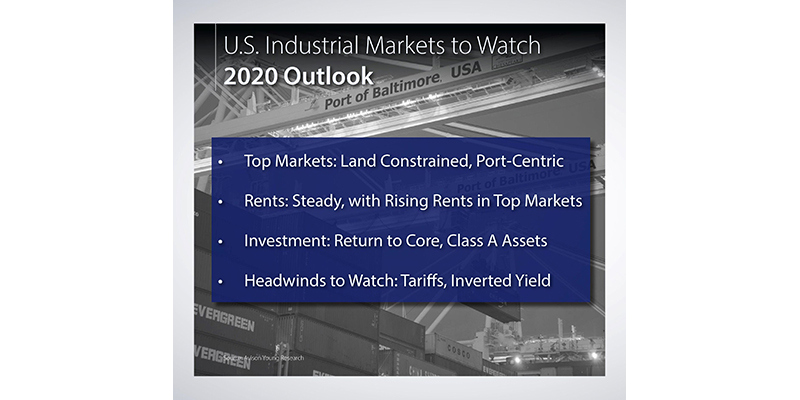Despite taking a dip in activity from the tariffs on Chinese goods. U.S. ports continue to benefit from the expansion in ecommerce, observe industrial real estate experts.
Furthermore, the 2020 outlook for U.S. industrial real estate remains positive, with low vacancy rates and rising rental rates balancing the influx of new construction and the volatility caused by economic shifts and the tariffs on Chinese imports, according to speakers at Avison Young's U.S. Industrial Summit.
Ports from Los Angeles and Long Beach, which together carry about 30 percent of U.S. container traffic, to Savannah, Miami, Houston and others are seeing strong demand for industrial space to support warehouse, distribution and logistics operations.
“Being a very port focused investor puts you right in the center of ecommerce,” said Jim Clewlow, Chief Investment Officer of CenterPoint Properties, a leading commercial real estate firm specializing in acquiring land and facilities near ports and intermodal facilities.
He also observed that “land-constrained markets,” where expansion of new space is limited, were noted as the top focus for many Industrial Summit executives.
“The Seattle, Los Angeles, Miami, Oakland and New Jersey markets, for example, have seen record growth and offer stability for the long-term, even if an economic downturn occurs,” said Clewlow.
Erik Foster, Avison Young Principal and leader of the firm's U.S. industrial capital markets group, told SCMR in an interview that The U.S. trade tensions are an issue that businesses need to factor into their operations.
“But we see this as a short-term concern that will not overshadow long-term growth in the industrial sector,” he added. “We’ve seen companies getting creative to work around the tariffs, from pre-ordering goods ahead of tariffs taking affect to shifting some of their buying to other countries, such as Vietnam.”

Meanwhile, port activity around the U.S. continues to be strong with some given the growth in ecommerce and the importance of port locations for distribution of products in and out of the country.
“For example, the South Carolina Port Authority announced an 8.8% increase in annual twenty-foot equivalent unit (TEU) container volume for their fiscal year ending June 30, 2019,” noted Foster. “Despite a decrease in Chinese imports of approximately 12% year to date, according to the U.S. Census Bureau, the Port Authority predicts growth at twice the rate of the national average.”
The South Carolina Ports Authority owns and operates terminals at two port facilities, The Port of Charleston and the Port of Georgetown, in addition to Inland Ports in Greer and Dillon, South Carolina.

SC
MR


Latest Supply Chain News
- How CPG brands can deliver on supplier diversity promises
- How S&OP provides the answer to in-demand products
- AI, virtual reality is bringing experiential learning into the modern age
- Humanoid robots’ place in an intralogistics smart robot strategy
- Tips for CIOs to overcome technology talent acquisition troubles
- More News
Latest Podcast

 Explore
Explore
Business Management News
- How CPG brands can deliver on supplier diversity promises
- How S&OP provides the answer to in-demand products
- AI, virtual reality is bringing experiential learning into the modern age
- Tips for CIOs to overcome technology talent acquisition troubles
- There is still work to do to achieve supply chain stability
- Blooming success: The vital role of S&OE in nurturing global supply chains
- More Business Management
Latest Business Management Resources

Subscribe

Supply Chain Management Review delivers the best industry content.

Editors’ Picks





